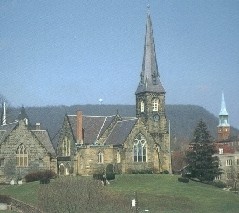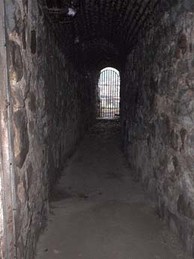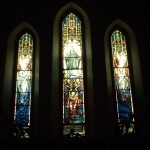With its consecration in 1851, the cornerstone being laid in 1849, Emmanuel Episcopal Church became the center of western Maryland’s Emmanuel Parish. The new building being constructed above the former site of Fort Cumberland, whose earthworks remained under the building. The earthworks created tunnels that were later used to conceal escaped slaves as part of the Underground Railroad. Emmanuel Parish established many other churches throughout the region, including churches in western Maryland and in what is now Romney and Moorefield, West Virginia. Visitors can view the churches many works of art including stained glass windows by taking a self-guided tour.
The area’s first Anglican service was likely held in 1749.
1 In
1800, the U.S. government sold Fort Cumberland to the Episcopalian and Presbyterian
congregates.
2 Cumberland’s first Episcopal church building was conceived in
1803, because of legal issues concerning the property the building and services
were not conducted there until 1830. The building’s construction was a collaborative
effort between Episcopalians and Presbyterians and was located on the site of
the current Emmanuel Episcopal site. Until the church’s completion,
Episcopalians used the Lutheran Church building for their services.
3
Cumberland’s
Episcopal community continued to grow and in 1849, the congregation began
construction of a new building. In 1851, the new building was completed.
Designed by John Notman of Philadelphia, the building’s architecture is the Medieval
English Gothic style.4 Louis Comfort
Tiffany designed many new features for the church in 1905. The congregation
added Tiffany’s designs to the building between 1905 and 1923. Tiffany’s work
included, but was not limited to stained glass.5 Henry Holiday, Charles
Goodhue, and McGill Mackell also contributed works of stained glass.6
A runaway slave
from Mississippi, named Samuel Denison, came to Cumberland in the 1850’s.
Denison and Emmanuel’s Rector, Reverend David Hillhouse Buel, worked together
to move escaped slave through Maryland and on to freedom. Old Fort Cumberland’s
earthworks provide a tunnel system under the church and its rectory, through
which Denison escorted runaway slaves after they had crossed the Potomac River
and hidden temporarily in the Shanty Town of lower Cumberland.7 Cumberland’s
Shanty Town residents were very poor and the area was not racially segregated,
providing a natural place to hide.8 The runaways first stopped under the church
where they received aid from abolitionists. Denison then escorted them through
a steam line tunnel through the basement of the Allegany County Academy, where
he also worked as a custodian, and on to the cellar of Emmanuel’s Rectory. The
Rectory’s cellar was located in a little seen area of town; from there the
runaways were spirited on to Pennsylvania.9
Emmanuel
Episcopal Church is active and continues to service the city of Cumberland.
Emmanuel Church is part of the Episcopal Diocese of Maryland. The church allows
self-guided tours of the stained glass; the church also offers guided tours of
the tunnels. Make contact with the church in order to arrange a tour. Emmanuel
Episcopal Church is part of the Washington Street Historic District, which is
on the National Register of Historic Places.1. “Colonial Era”, The Emmanuel Parish of The Episcopal Church, accessed April 4, 2015, http://www.emmanuelparishofmd.org/?page_id=161
2. “Early Years as a Parish”, The Emmanuel Parish of The Episcopal Church, accessed April 4, 2015, http://www.emmanuelparishofmd.org/?page_id=167
3. Lowdermilk, Will H., “History of Cumberland, (Maryland)”, (Washington: James Anglin, 1878), GooglePlay, accessed April 3, 2015, pp. 461-62
4. “The New Church”, The Emmanuel Parish of The Episcopal Church, accessed April 4, 2015, http://www.emmanuelparishofmd.org/?page_id=169
5. “Louis Comfort Tiffany”, The Emmanuel Parish of The Episcopal Church, accessed April 4, 2015, http://www.emmanuelparishofmd.org/?page_id=175
6. “Other Artist’s”, The Emmanuel Parish of The Episcopal Church, accessed April 4, 2015, http://www.emmanuelparishofmd.org/?page_id=177
7. “Emmanuel and The Underground Railroad”, The Emmanuel Parish of The Episcopal Church, accessed April 4, 2015,
http://www.emmanuelparishofmd.org/?page_id=171
8. Roberts, Vernon Mr., “Emmanuel Episcopal Church Cumberland, Maryland”, Legacy of Slavery in Maryland, Maryland State Archives, accessed April 4, 2015, http://slavery.msa.maryland.gov/html/casestudies/fifeec.html
9. “Emmanuel and The Underground Railroad”, The Emmanuel Parish of The Episcopal Church, accessed April 4, 2015



